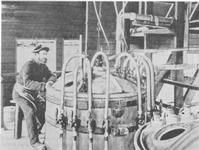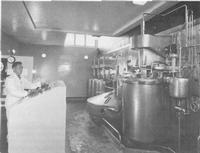


Chapter 9
I Introduction
II The Australian Chemical Industry
i Beginnings 1865-1919
ii Fertilisers
iii Raw materials from gasworks and coke ovens
iv The beginnings of industrial chemical research - in the sugar industry
v Explosives
III Pharmaceuticals
IV Chemists In Other Industries
V The Dawn Of Modern Chemical Industry - High Pressure Synthesis
VI The Growth Of Synthetic Chemicals - Concentration, Rationalisation And International Links
VII Australian Industrial Chemical Research Laboratories
VIII The Plastics Industry
IX The Paint Industry
X Acknowledgements
References
Index
Search
Help
Contact us

The small operation experienced many difficulties; technical problems, a few accidents, strict supervision by the authorities and lack of resources compared with Nobel's technically superior competition. Gelignite from 1885 onward rapidly conquered the market and became a major setback for the Australian manufacturers since it was patent protected to Nobel's licensees. Nevertheless, Nobel's Explosives at Glasgow did not have the market to themselves either, because production of dynamite and gelignite had been delayed in the UK by official intervention and timidity. In the meantime Nobel's German licensees had penetrated the Australian market energetically. Nobel was both licensor and a member of the Boards of the Glasgow company and of Dynamit Aktiengesellschaft; he was influential but could give orders to neither party. Yet he was apparently concerned about the economics of scale and expressed his concern about the penetration of the German company into the Australian market. Nevertheless German imports persisted to the outbreak of the First World War and ranged from one fifth to one third of total imports between 1900 and 1910.
In spite of the much larger plants in Germany and the UK and the flow of research results from their and Nobel's Paris research laboratories, the valiant little Deer Park company survived for some decades. Its problems increased, however, when yet another major Nobel invention, the military explosive 'ballistite' (invented 1887) and its British analogue 'cordite' emerged. Both were patent protected and likely to be beyond the resources of the company; in addition 'cordite' was being developed by the British War Office, and Australian defence forces, then closely linked to the UK, were likely to follow the British pattern, as indeed they did later on the recommendation of the Chief Inspector of Explosives, Napier Hake.
Nobel, on the other hand, had consistently pursued a policy of decentralising manufacture in partnership with local interests in the major markets, as a symbiosis of local and his corporate interests. Australia had become a major market and his early patents were beginning to run out. The time to take an interest in local manufacture had come. Nobel's U.K. progressively increased their shareholding in Australian Explosives and Chemicals Company (the company had abandoned its German name Krebs in 1888) and in 1898 acquired the enterprise as a basis for future expansion. From 1890 the plant produced blasting gelignite; in 1925 it changed its name to Nobel (Australasia) Ltd. and in 1928 the company was incorporated in ICIANZ (now ICI Australia) Ltd. as one of the foundation stones of Australia's largest chemical company.{36}
Deer Park progressively expanded; its by-product acid was used in a small fertiliser factory. Its explosives production was modernised and built-up to become the centre of explosives supply for the Australian mining industry for over five decades. In 1956 the most sensitive manufacturing step, the nitration of glycerol, was fully automated in a 2000 kg/hr Biazzi plant, the largest plant in the world -a far cry from the early 'days of Ardeer and Deer Park, when the operator had to sit on a one-legged stool ito ensure that he did not dose off during this critical step (Figs. 6 and 7).


Organisations in Australian Science at Work - Australian Explosives and Chemical Company Ltd; I.C.I. Australia Ltd; Nobel (Australasia) Ltd
People in Bright Sparcs - Hake, C. Napier; Krebs, Friedrich
 |
Australian Academy of Technological Sciences and Engineering |  |
© 1988 Print Edition pages 641 - 643, Online Edition 2000
Published by Australian Science and Technology Heritage Centre, using the Web Academic Resource Publisher
http://www.austehc.unimelb.edu.au/tia/610.html